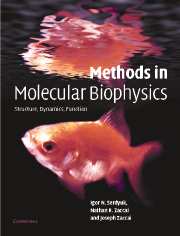Book contents
- Frontmatter
- Contents
- Foreword by D. M. Engelman
- Foreword by Pierre Joliot
- Preface
- Introduction: Molecular biophysics at the beginning of the twenty-first century: from ensemble measurements to single-molecule detection
- Part A Biological macromolecules and physical tools
- Part B Mass spectrometry
- Chapter B1 Mass and charge
- Chapter B2 Structure function studies
- Part C Thermodynamics
- Part D Hydrodynamics
- Part E Optical spectroscopy
- Part F Optical microscopy
- Part G X-ray and neutron diffraction
- Part H Electron diffraction
- Part I Molecular dynamics
- Part J Nuclear magnetic resonance
- References
- Index of eminent scientists
- Subject Index
- References
Chapter B2 - Structure function studies
from Part B - Mass spectrometry
Published online by Cambridge University Press: 05 November 2012
- Frontmatter
- Contents
- Foreword by D. M. Engelman
- Foreword by Pierre Joliot
- Preface
- Introduction: Molecular biophysics at the beginning of the twenty-first century: from ensemble measurements to single-molecule detection
- Part A Biological macromolecules and physical tools
- Part B Mass spectrometry
- Chapter B1 Mass and charge
- Chapter B2 Structure function studies
- Part C Thermodynamics
- Part D Hydrodynamics
- Part E Optical spectroscopy
- Part F Optical microscopy
- Part G X-ray and neutron diffraction
- Part H Electron diffraction
- Part I Molecular dynamics
- Part J Nuclear magnetic resonance
- References
- Index of eminent scientists
- Subject Index
- References
Summary
Protein structure and function
ESI and MALDI have become increasingly useful for the mass spectrometric analysis of proteins. The two ionisation techniques have been exploited to study protein folding, to characterise non-covalent protein complexes, to map protein function and for many other applications (Comment B2.1).
Comment B2.1: Mass spectrometry and X-ray crystallography
It is very useful to use mass spectrometry prior to X-ray crystallography. Indeed, the determination of a protein structure at atomic resolution takes a considerable investment of time and effort (see Chapter G3). Mass spectrometry permits a rapid check of the correctness of the accepted primary structure of a protein, and high-resolution determination of the purity of protein preparations. The information is particularly important for proteins obtained by recombinant techniques, which are subject to a number a special sources of error, including unanticipated mutations, modifications, termination and proteolitic degradation. A simple molecular mass measurement is so informative and time saving that there is a reason to obtain the mass spectrum of virtually every protein before it is subject to X-ray crystallography. It is especially important for proteins produced with special amino acid residues (e.g. selenomethionine), for NMR with 13C and/or 15N enrichment and for neutron small-angle scattering with specific deuteration. In the last case the incorporation of deuterium into biological macromolecules by biosynthetic methods is routinely determined by mass spectrometry measurements.
Mass determination
ESI and MALDI have made the mass analysis of proteins a routine procedure.
Information
- Type
- Chapter
- Information
- Methods in Molecular BiophysicsStructure, Dynamics, Function, pp. 136 - 170Publisher: Cambridge University PressPrint publication year: 2007
